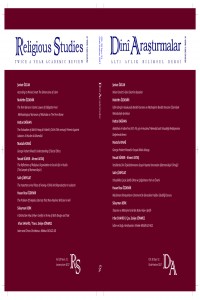Abstract
The arguments in order to prove the Qur’anic Christology is found about the axis of Makka, Najrān and ‘Ukāẓ. This article deals with Prophet Muhammad’s vast relations with Christians in his pre-prophesy and Mecca periods; also how it reflects on Qur'an and its dogmas. The first focus of the Qur’anic Christology was Makka. Because the west of the Arabian Peninsula, where Makka was included, especially Najrān, in the sixth century, one side under the influx of Ethiopians and from the Aryans, Monophysites and Nesturites which rejected by the Orthodox Byzantine on the other side. Christianity in Makka was represented by Arabs and Ethiopians who settled there. There were quite a lot of Ethiopians in Makka during the emergence of Islam and they were working in various services of the Makkans. In this process, many christian concepts such as ‘Isā, Hawāriyyūn, Naṣārā passed into Arabic from Ethiopian litrature; so accordingly these were used in Qur’an. The second major origin of the Qur'anic Christology was Najrān. Prophet Muhammad encountered with Christian Bishop of Najrān, Quss Ibn Sā’ida al-Iyādī, in the “Suq of 'Ukāẓ/Makka Market” near the city and listened him on a camel while he was preaching Monotheism. Moreover, Qur’an spoke of Najran Martyrs. The poetry, plain writing style and oratorical style of the rabic language were used by both Najrān Christian missionaries and Prophet Muhammad itself. Besides, it is notable that Qur’an is a unique book and masterpiece work both in terms of Arabic language and îcâz.
Keywords
References
- Irfan Shahid, " Islam And Oriens Christianus: Makka 610-622 Ad", ("ed." Emmanouela Grypeou, Mark Swanson ve David Thomas), The Encounter of Eastern Christianity with Early Islam, (Leiden - Boston, Brill, 2006), ss.9-31.
Abstract
Kur’an’î Kristoloji’nin delilleri; Mekke, Necrân ve ‘Ukâz ekseninde oluşturulmaktadır. Makalede, Hz. Muhammed’in peygamberlik öncesinde ve Mekke döneminde Hıristiyanlarla münasebetleri, bunun Kur’an’a yansımaları ve Kur’an’ın dogmaları ele alınmaktadır. Kur’an’î Kristoloji’nin ilk merkezi Mekke’dir. Çünkü Mekke’nin de dahil olduğu Arap Yarımadası’nın batısı, altıncı yüzyılda bir taraftan Etiyopyalılar, diğer taraftan Ortodoks Bizans tarafından reddedilen Ariusçuların, Monofizitlerin ve Nesturîlerin akınına uğradı. Mekke’deki Hıristiyanlık, Araplar ve Mekke’ye yerleşen Etiyopyalılar tarafından temsil edildi. Bu süreçte Îsa, Havâriyyûn, Nasârâ gibi birçok Etiyopyaca kelime Arapçaya geçmiş ve Kur’an’da da kullanılmıştır. Kur’anî Kristoloji’nin ikinci büyük menşei Necrân’dı. Hz. Muhammed, Mekke’nin yakınındaki ʻUkâz Fuarı’nda Necrân’ın Hıristiyan Piskoposu Kuss b. Sâide elİyâdî’yle karşılaştı ve onu Monoteizm’i vaaz ederken dinledi. Ayrıca Kur’an, Necrân şehitlerinden söz etti. Arap dilinin şiiri, düz yazı üslubu ve hitabet tarzı hem Necrân Hıristiyan misyonerleri hem de Hz. Muhammed tarafından kullanıldı. Bunların yanı sıra Kur’an hem dil hem de îcâz olma bakımından eşsiz bir kitaptır.
Keywords
References
- Irfan Shahid, " Islam And Oriens Christianus: Makka 610-622 Ad", ("ed." Emmanouela Grypeou, Mark Swanson ve David Thomas), The Encounter of Eastern Christianity with Early Islam, (Leiden - Boston, Brill, 2006), ss.9-31.
Details
| Journal Section | Tercümeler |
|---|---|
| Authors | |
| Publication Date | June 15, 2017 |
| Published in Issue | Year 2017 Volume: 20 Issue: 51 (19-06-2017) |


